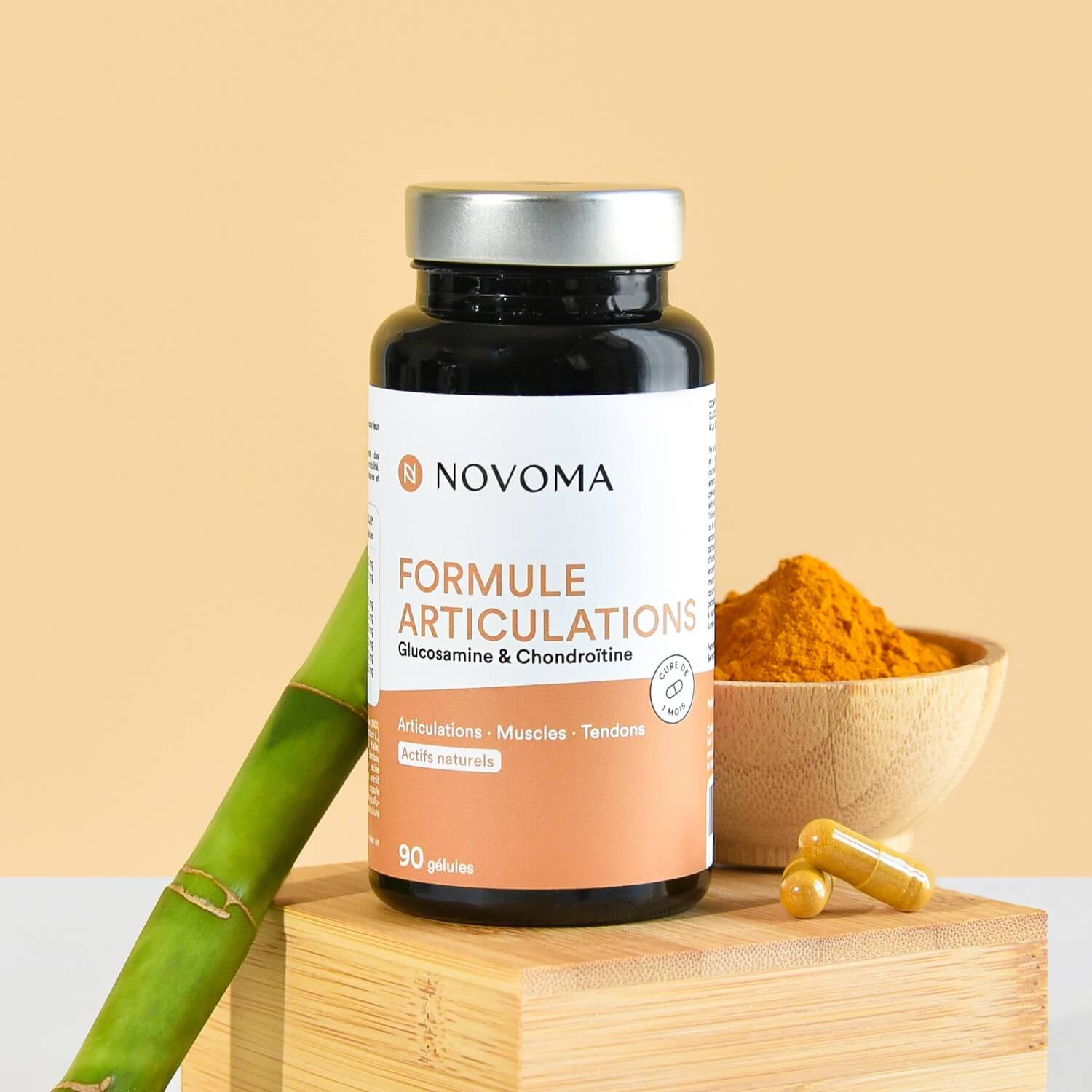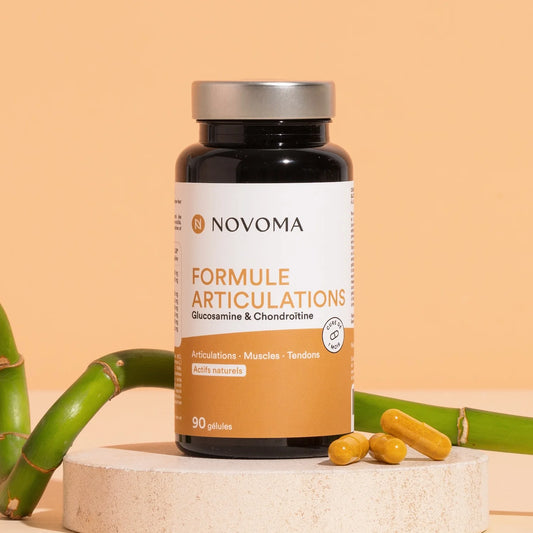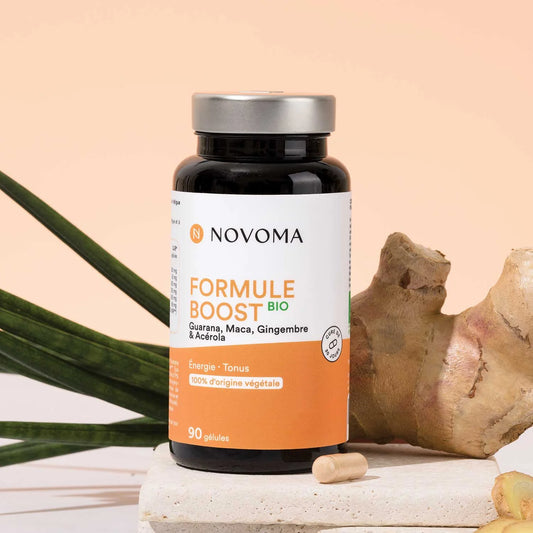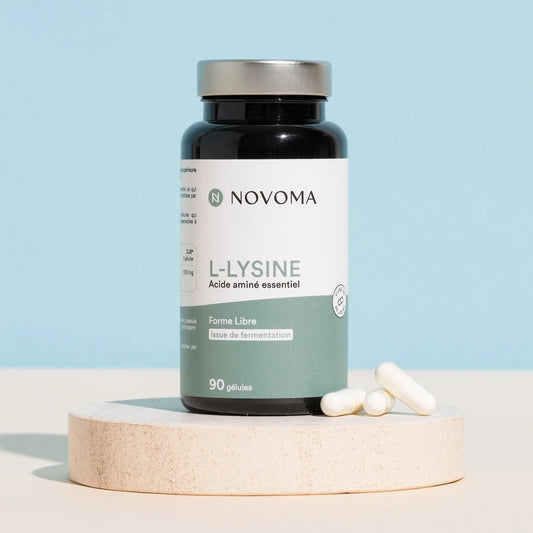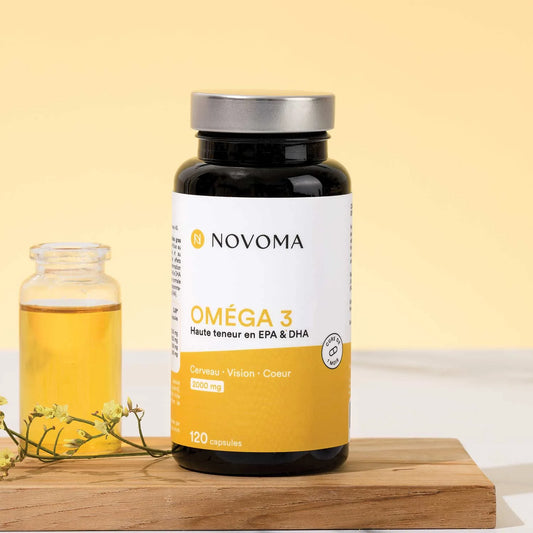
Joint discomfort: what is the best food supplement for joints?
Summary
Natural aging is often blamed for joint discomfort. But proper joint function is not just a matter of the number of years on the clock (it would be so simple).
Physical activity, just like a sedentary lifestyle or diet, are also factors that can cause joint fatigue. This is where a joint supplement can make a difference.
But before rushing to a miracle solution, it is important to understand the origin of the signs of discomfort in order to adopt the right reflexes and... to optimize the benefits through relevant supplementation!
Our team has been looking into this topic for years: find out in this article everything you need to know about the possible causes of joint discomfort, and how to choose the best food supplement for joints .
Precision, and not the least! The best food supplement, in our eyes, is always: a formula chosen according to your needs, correctly dosed and adapted to your lifestyle.
No fuss or crazy promises, transparency or nothing.
What is the role and function of joints?
Joints are the areas of contact between bones, they are an integral part of the structure of the skeleton.
As long as they don't bother us, we tend to forget about them (and sometimes, mistreat them). However, they are essential to everyday life, ensuring the movement of limbs and the support of the body.
However, 1 in 2 French people say they are affected by chronic joint discomfort , including 1 in 3 young people, which can even cause changes in sleep and mood, sometimes leading to the cessation of physical activity.

What are the types of joints and their structure?
Joints are made up of several elements dedicated to ensuring the body's movements. Located at the end of the bones, they do not all have the same use. While some only serve to support our posture, others ensure our mobility.
💡 Did you know? There are between 300 and 380 joints in adults – scientific experts do not all agree among themselves!
There are 3 classes of joints according to the range of movement permitted (functional categorization) or according to their composition (morphological categorization):
- ➡️ Synarthroses or “fibrous joints” : immobile, and provide structural support ( top of the skull, between the teeth and the jaw, etc. );
- ➡️ Amphiarthroses or “cartilaginous joints” : partially mobile, they combine slight movement and stability ( for example the junction between the sternum and the ribs );
- ➡️ Diarthroses or “synovial joints” : they provide greater range of movement ( hip, knee, ankle, arm, etc. ).
What are the different components of joints and their role?
Regardless of the range of motion permitted, joints are made up of several elements:
Subchondral bone ;
-
Cartilage : it protects the joints during rapid and repeated movements, and serves as a shock absorber! It is composed of collagen, hyaluronic acid, chondrocytes (contributing to the synthesis of collagen in cartilage) and proteoglycans (proteins responsible for many cellular activities).
The fibrous capsule and the synovial membrane : the latter secretes synovial fluid, while ensuring the immune response to eliminate foreign bodies ;
Synovial or joint fluid : produced by the synovial membrane, it serves as a lubricant.

The image above shows the successive stages of joint deterioration in a knee, illustrating how cartilage can gradually degrade. There is a transition from a healthy joint to a significantly affected joint. This evolution highlights the importance of regular attention to our joint well-being, adopting support strategies, such as a balanced diet and the judicious use of food supplements to maintain joint well-being, in accordance with the recommendations of health authorities.
How does the joint movement mechanism work?
As you may have guessed, our movement does not only depend on our 350 or so joints , but also on the action of muscles on bones by tendons (which connect the muscles to the bone) as well as ligaments which connect the bones together.
These muscular actions cause the various movements of the body, from the smallest to the largest (flexion and extension, abduction and adduction, etc.).
💡 Remember : the amplitude depends on the elasticity of the ligaments and joint capsules, and its fluidity on the proper functioning of our joints… which can be a source of discomfort , the central point of our article!
Joint discomfort: what are the causes of joint dysfunction?
Avid athlete, constant sitting (hello teleworking), back numb from the weight of a baby carried at arm's length, and, let's face it, age: joint discomfort will affect us all one day!
These feelings of discomfort can be truly disabling. Once the possible causes have been identified, appropriate measures can be taken to take care of your joints .
Natural aging and the progressive degradation of tissues
📈 The numbers : nearly 10 million French people are affected by osteoarthritis, 65% of whom are over 65 years old . In addition to prevention and measures related to healthy living, research is looking into processes aimed at repairing cartilage, in particular through joint grafts and tissue bioengineering...
Cellular aging leads to a degradation of certain body functions. Collagen production stops at the age of 25 , and gradually decreases. Since it is one of the constituent elements of the connective tissues of the human body, its decrease can also lead to reduced joint flexibility.
The same goes for hyaluronic acid , whose production decreases with age, leading to the alteration of cellular functions.
Joint disorders and lifestyle: sedentary lifestyle, overweight and diet
Lifestyle helps to understand the context of people affected by joint discomfort, and to identify the cause (apart from any conclusion established by a professional).
How can we expect to have quality joint mobility if we spend our days sitting? Or if excess weight puts a strain on our joints?
Lifestyle factors:
Sedentary lifestyle : insufficient physical activity is harmful to well-being! Movement is essential for the proper functioning of the body (and the rise of professions behind a screen has not helped);
-
Overweight and obesity : Being overweight puts significant pressure on the joints, leading to an increased risk of cartilage erosion;
Diet : since discomfort can result from excess fat mass (and weight), it is advisable to limit certain foods (red meat, cold cuts, industrial dishes, sugary products and drinks, etc.).
Repetitive movements and intensive physical activity
You must have heard about the collateral damage linked to activities - most often professional - which involve repeated movements.
Also called musculoskeletal disorders (MSDs), they mainly affect the joints, muscles and tendons of the upper limbs (back, shoulders, arms). These discomforts result from stress exerted on certain areas of the body. In addition to the discomfort felt, those affected may also be subject to sleep disorders, reduced mobility and a higher risk of mood disorders.
But sport is not left out: intensive or inappropriate physical activity, combined with insufficient rest , can cause joint erosion. The risk? Repeated injuries, joint and muscle discomfort during exercise and an increased risk of joint damage .

What is the best joint supplement?
While prevention is the priority, supplementation can help support joints and relieve discomfort. How to choose a dietary supplement for joints ? What is the best supplement for proper joint function ?
The best active ingredients for joints
Several specific nutrients (molecules, vitamins and plant extracts) have been identified by research as being able to promote joint well-being, including two key molecules:
Glucosamine : This molecule naturally present in connective tissues (cartilage, tendons, bones and skin) is a precursor of keratin, collagen and hyaluronic acid. It plays a role in maintaining the integrity of cartilage.
Chondroitin : this molecule is found in the connective tissues of the body, whose role is to contribute to the formation and maintenance of cartilage tissue .
The ingredients selected for our joint food supplement
For our Joint Formula , we have chosen to focus on two key molecules, supplemented by other ingredients in order to optimize its effectiveness on joint well-being:
✅ Glucosamine in 100% plant-based sulfate form, obtained by natural bio-fermentation (and showing better effectiveness than glucosamine HCl sulfate);
✅ Phytodroitin™ , a 100% plant-based alternative that mimics the structure and composition of chondroitin;
✅ Bamboo extract, which promotes bone comfort and strength;
✅ Turmeric , which contributes to joint health and flexibility;
✅ Devil's claw to support joint mobility.
We recommend you
Joints Formula
Our 100% plant-based formula based on 5 natural active ingredients recognized for their properties on joints, muscles, and tendons!
- ✅ Synergy of 5 natural active ingredients
- ✅ Dosages studied for optimal effectiveness
- ✅ 1 month treatment
- ✅ Made in France 🇫🇷
An adapted dosage
At Novoma, we rigorously respect dosage standards for each nutrient in our formulas.
What does “appropriate dosage” mean? Sufficient to be effective and keep its promises (with the DJR label, for “Recommended Daily Dose”), without going beyond what is authorized by law for food supplements.
User reviews and proven effectiveness
Beyond designing a product adapted to the needs of the body, it is your opinions that attest to its effectiveness! And your feedback warms our hearts…
Thanks to our ambassador program , we submitted the joint formula to a concrete test over 2 months with 50 people, in order to obtain reliable, proven effectiveness data and as much detail as possible on their opinions.
Assessment after the first month?
✅ 91 % feel a reduction in joint pain or discomfort and 83% an improvement in their joint mobility;
✅ 69% noticed an improvement in their physical activities ;
✅ 74 % observed benefits on muscle recovery.
And their feedback is clear! 🤌

Guarantees on the traceability and transparency of the brand
A transparent brand means supplements that clearly display the origin of the raw materials and the places of manufacture.
👀 All the certificates of analysis of our products are available on our product sheets. In other words, you could have fun preparing them in your kitchen (or not).
The formula’s certifications and quality labels
Certifications and labels for food supplements help to attest to the reliability and quality of the formulas.
🌱 At Novoma, all our products are certified GMO-free, without controversial chemical additives, without magnesium stearate and Cruelty Free. Our Joint Formula is also made in France and vegan!
Cost and Value for Money
By internalizing our logistics and favoring local partners (sourcing, manufacturing, packaging and storage), we ensure a fair final price for the greatest number.
The Joint Formula is priced at €24.90 for 1 month of treatment, knowing that the subscription option allows you to receive it every month, while benefiting from -10% on the price . It's up to you to decide what suits you best!
Other interesting supplements for joint comfort
If you want to optimize your joint comfort, you can combine it with other nutrients, in addition to the formula or as an alternative :
Vitamin D3: contributes to normal serum calcium levels, as well as to the functioning of the immune system and the maintenance of bone and muscle function .
➡️ Discover our 100% natural and bioavailable vitamin D3 .
Collagen : Since it is one of the building blocks of cartilage , it will be a relevant choice of supplementation to support joint comfort, especially when combined with Vitamin C, which contributes to the normal function of collagen .
➡️ If this option speaks to you, our marine collagen enriched with vitamin C might interest you.

How to relieve joint discomfort? Our tailor-made advice
Opt for a food supplement for the joints
Supplementation rhymes with prevention! If joint discomfort is already present, a dietary supplement for the joints can help relieve the discomfort, while contributing to better flexibility in your movements.
💡You can opt for a complete formula , or rely on supplements containing each nutrient separately.
Reflexes to adopt on a daily basis: physical exercise, diet and gentle practices
Certain habits can help prevent (or even relieve) joint discomfort and aches :
Adapted physical activity:
⛹️ Before talking about sports, think about integrating more movement into your daily life! A few stretches when you wake up, a walk around the neighborhood at lunchtime if you work from home, regular family walks. It's up to you to find what is right for your physical condition , and that you can maintain in the long term without losing motivation.
A diet rich in nutrients :
🍽️ Choose fresh, seasonal fruits and vegetables, and include foods rich in Omega-3 polyunsaturated fatty acids (salmon, sardines, anchovies, mackerel, etc.) on your menu every week. As a bonus, turmeric and ginger are two ingredients known for their properties on the joints!
Gentle practices :
🧘 Psychocorporeal approaches can contribute to psychological well-being (meditation, relaxation, yoga, etc.). Try it to promote relaxation!
Consult a healthcare professional
When it comes to joint discomfort, it is always best to seek the advice of a professional or your doctor.
Any doubts or questions? Do not hesitate to contact us and we will advise you on choosing the food supplement best suited to your situation.
FAQ
What is the best food for joints?
Foods rich in omega-3 remain the star of joint comfort. Oily fish (sardines, tuna, mackerel) are an excellent source of omega-3 fatty acids.
What is the most effective joint supplement?
An effective dietary supplement for joint comfort may contain turmeric, omega-3 from fish oil, collagen, chondroitin and glucosamine.
What vitamin should I take for my joints?
Vitamin D3 is beneficial for the joints, it contributes to normal calcemia and to the maintenance of the bone structure.





